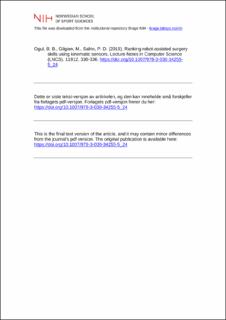| dc.contributor.author | Ogul, Burcin Buket | |
| dc.contributor.author | Gilgien, Matthias | |
| dc.contributor.author | Sahin, Pinar Duygulu | |
| dc.date.accessioned | 2020-12-15T09:05:00Z | |
| dc.date.available | 2020-12-15T09:05:00Z | |
| dc.date.created | 2020-01-21T12:17:43Z | |
| dc.date.issued | 2019 | |
| dc.identifier.citation | Lecture Notes in Computer Science (LNCS). 2019, 11912, 330-336. | en_US |
| dc.identifier.issn | 0302-9743 | |
| dc.identifier.uri | https://hdl.handle.net/11250/2719438 | |
| dc.description | I Brage finner du siste tekst-versjon av artikkelen, og den kan inneholde ubetydelige forskjeller fra forlagets pdf-versjon. Forlagets pdf-versjon finner du på link.springer.com / In Brage you'll find the final text version of the article, and it may contain insignificant differences from the journal's pdf version. The definitive version is available at link.springer.com | en_US |
| dc.description.abstract | Assessing surgical skills is an essential part of medical performance evaluation and expert training. Since it is typically conducted as a subjective task by individuals, it may lead to misinterpretations of the skill performance and hence lead to suboptimal training and organization of the surgical activities. Therefore, objective assessment of surgical skills using computational intelligence techniques via sensory data has received attention from researchers in recent years. So far, the problem has been approached by employing a classification model where a query action for surgery is assigned to a predefined category that determines the level of expertise. In this study, we consider the skill assessment problem as a pairwise ranking task where we compare two input actions to identify better surgical performance. To this end, we propose a hybrid Siamese network that takes two kinematic motion data acquired from robot-assisted surgery sensors and report the probability of the first sample having a better skill than the second one. Experiments on annotated real surgery data reveals that the proposed framework has high accuracy and seems sufficiently accurate for use in practice. This approach may overcome the limitations of having consistent annotations to define skill levels and provide a more interpretable means for objective skill assessment. | en_US |
| dc.language.iso | eng | en_US |
| dc.title | Ranking robot-assisted surgery skills using kinematic sensors | en_US |
| dc.type | Peer reviewed | en_US |
| dc.type | Journal article | en_US |
| dc.description.version | acceptedVersion | en_US |
| dc.source.pagenumber | 330-336 | en_US |
| dc.source.volume | 11912 LNCS | en_US |
| dc.source.journal | Lecture Notes in Computer Science (LNCS) | en_US |
| dc.identifier.doi | 10.1007/978-3-030-34255-5_24 | |
| dc.identifier.cristin | 1779123 | |
| dc.description.localcode | Institutt for fysisk prestasjonsevne / Department of Physical Performance | en_US |
| cristin.ispublished | true | |
| cristin.fulltext | postprint | |
| cristin.qualitycode | 1 | |
